Discover 35 hidden attractions, cool sights, and unusual things to do in Bath (United Kingdom). Don't miss out on these must-see attractions: Roman Baths, Bath Abbey, and Royal Crescent. Also, be sure to include Victoria Art Gallery in your itinerary.
Below, you can find the list of the most amazing places you should visit in Bath (England).
Table of Contents
Roman Baths

Thermae in Bath, England. The Roman Baths are well-preserved thermae in the city of Bath, Somerset, England. A temple was constructed on the site between 60-70AD in the first few decades of Roman Britain. Its presence led to the development of the small Roman urban settlement known as Aquae Sulis around the site. The Roman baths—designed for public bathing—were used until the end of Roman rule in Britain in the 5th Century AD. According to the Anglo-Saxon Chronicle, the original Roman baths were in ruins a century later. The area around the natural springs was redeveloped several times during the Early and Late Middle Ages.
The Roman Baths are preserved in four main features: the Sacred Spring, the Roman Temple, the Roman Bath House, and a museum which holds artefacts from Aquae Sulis. However, all buildings at street level date from the 19th century. It is a major tourist attraction in the UK, and together with the Grand Pump Room, receives more than 1.3 million visitors annually. Visitors can tour the baths and museum but cannot enter the water.[1]
Address: Stall St, BA1 1LZ Bath
Bath Abbey
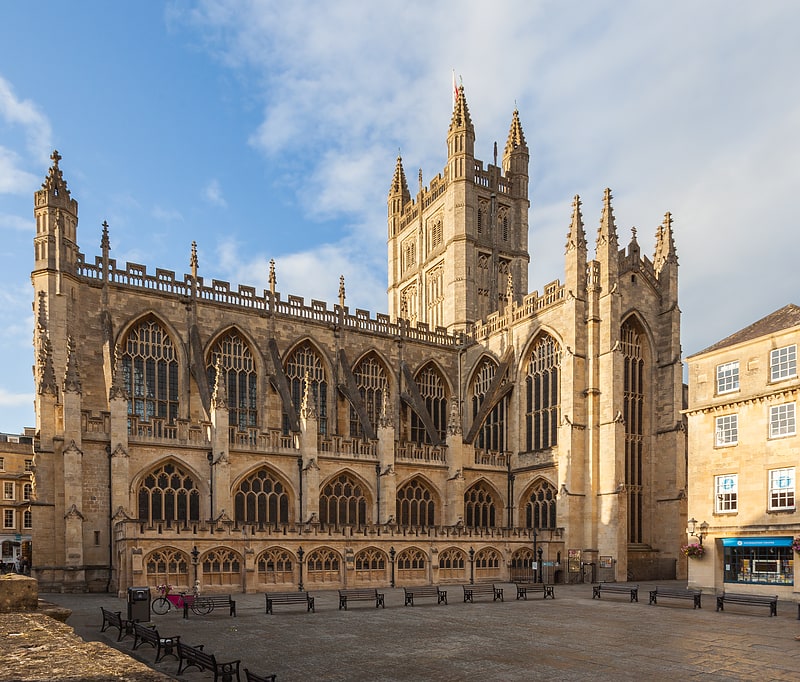
Medieval building with a Gothic interior. Bath Abbey is a parish church of the Church of England and former Benedictine monastery in Bath, Somerset, England. Founded in the 7th century, it was reorganised in the 10th century and rebuilt in the 12th and 16th centuries; major restoration work was carried out by Sir George Gilbert Scott in the 1860s. It is one of the largest examples of Perpendicular Gothic architecture in the West Country. The medieval abbey church served as a sometime cathedral of a bishop. After long contention between churchmen in Bath and Wells the seat of the Diocese of Bath and Wells was later consolidated at Wells Cathedral. The Benedictine community was dissolved in 1539 during the Dissolution of the Monasteries.
The church architecture is cruciform in plan and can seat up to 1,200 patrons. An active place of worship, it also hosts civic ceremonies, concerts and lectures. There is a heritage museum in the cellars.
The abbey is a Grade I listed building, particularly noted for its fan vaulting. It contains war memorials for the local population and monuments to several notable people, in the form of wall and floor plaques and commemorative stained glass. The church has two organs and a peal of ten bells. The west front includes sculptures of angels climbing to heaven on two stone ladders, representing Jacob's Ladder.[2]
Address: 12 Kingston Buildings, BA1 1LT Bath
Royal Crescent
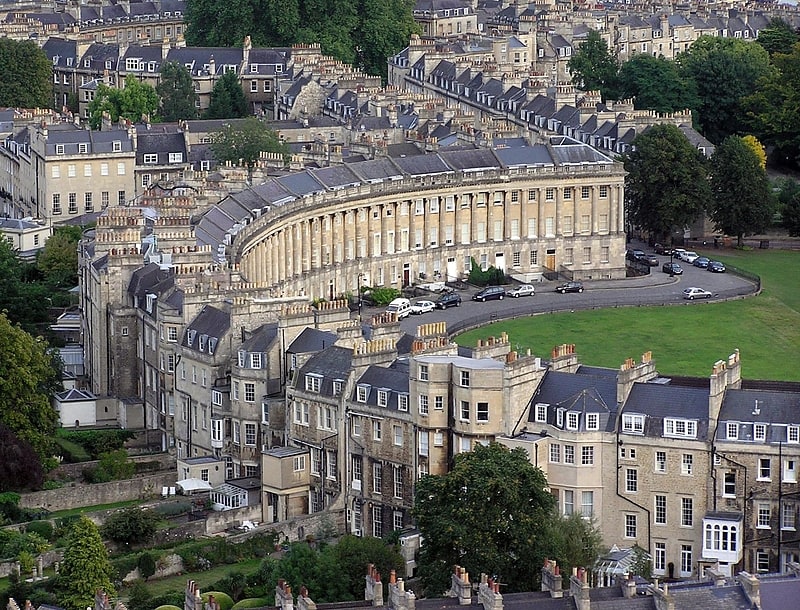
Building complex. The Royal Crescent is a row of 30 terraced houses laid out in a sweeping crescent in the city of Bath, England. Designed by the architect John Wood, the Younger and built between 1767 and 1774, it is among the greatest examples of Georgian architecture to be found in the United Kingdom and is a Grade I listed building. Although some changes have been made to the various interiors over the years, the Georgian stone facade remains much as it was when first built.
The 500-foot-long (150 m) crescent has 114 Ionic columns on the first floor with an entablature in a Palladian style above. It was the first crescent of terraced houses to be built and an example of "rus in urbe" (the country in the city) with its views over the parkland opposite.
Many notable people have either lived or stayed in the Royal Crescent since it was built over 240 years ago, and some are commemorated on special plaques attached to the relevant buildings. Of the crescent's 30 townhouses, 10 are still full-size townhouses; 18 have been split into flats of various sizes; one is the No. 1 Royal Crescent museum and the large central house at number 16 is The Royal Crescent Hotel & Spa.[3]
Address: Royal Cres, BA1 2LS Bath
Victoria Art Gallery
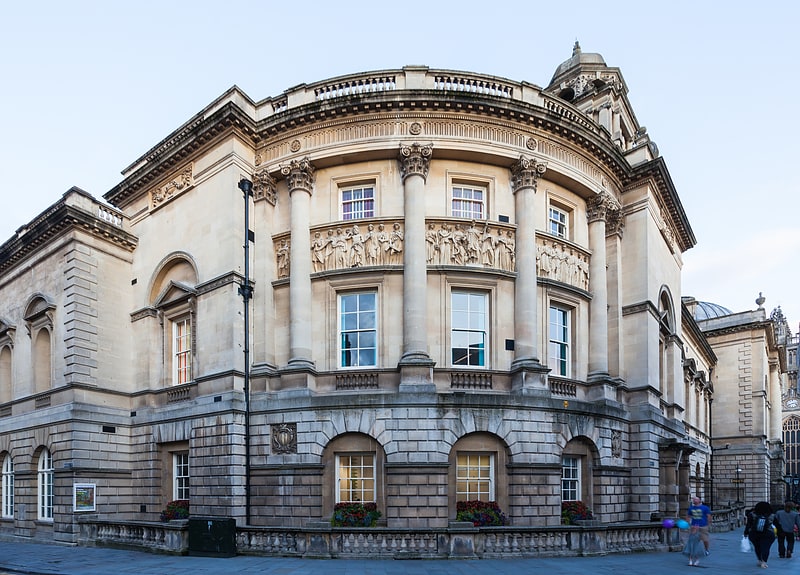
Museum in Bath, England. The Victoria Art Gallery is a public art museum in Bath, Somerset, England. It was opened in 1900 to commemorate Queen Victoria's diamond jubilee. It is a Grade II* listed building and houses over 1500 objects of art including a collection of oil paintings from British artists dating from 1700 onwards. The ground floor was at one time a public library.[4]
Address: Bridge St, BA2 4AT Bath
No. 1 Royal Crescent
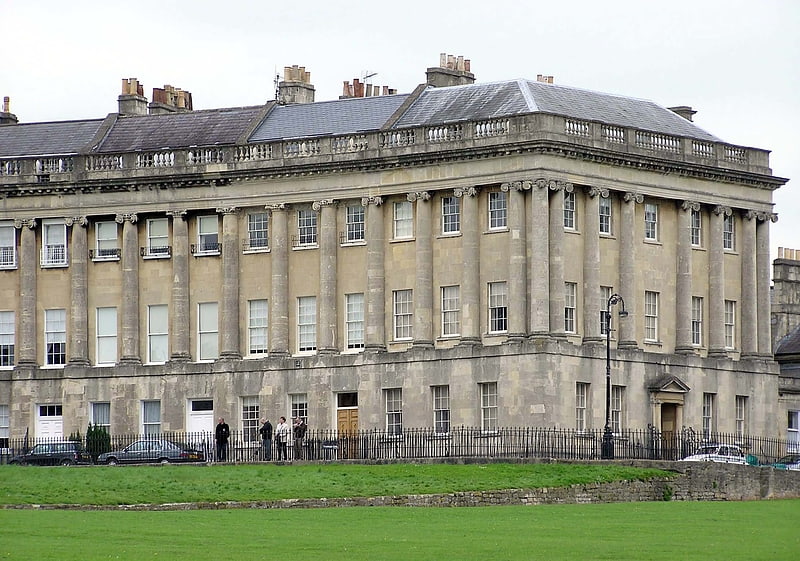
Museum in Bath, England. No. 1 Royal Crescent is the first building at the eastern end of the Royal Crescent in Bath, Somerset, and is of national architectural and historic importance. It is currently the headquarters of the conservation charity, the Bath Preservation Trust, and also operates as a public "historic house" museum displaying authentic room sets, furniture, pictures and other items illustrating Georgian domestic life both 'above stairs' and 'below stairs'. The house was the subject of a major renovation project during 2012 and 2013 which reunited No. 1 with its original service wing at No. 1A, from which it had been separated during the 20th century.[5]
Address: Royal Crescent, BA1 2LR Bath
Pulteney Bridge
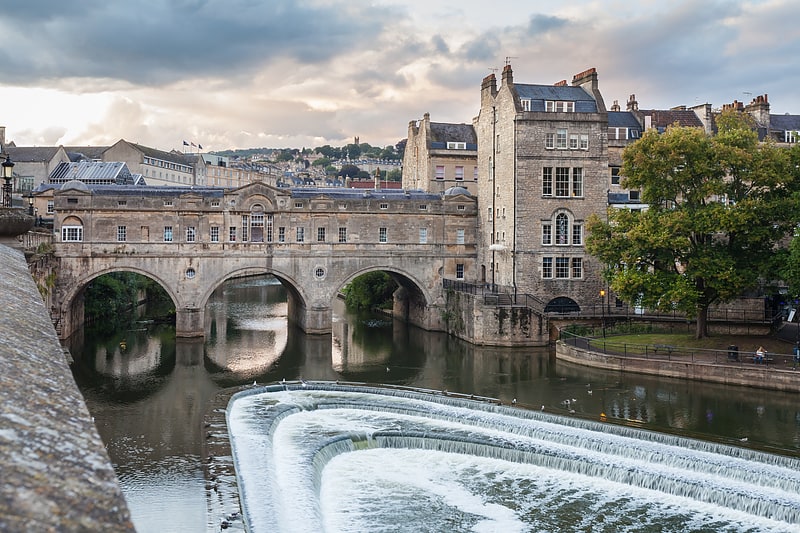
Picturesque bridge lined with shops. Pulteney Bridge is a bridge over the River Avon in Bath, England. It was completed by 1774, and connected the city with the land of the Pulteney family which it wished to develop. Designed by Robert Adam in a Palladian style, it is highly unusual in that it has shops built across its full span on both sides. It has been designated as a Grade I listed building.
Within 20 years of its construction, alterations were made that expanded the shops and changed the façades. By the end of the 18th century it had been damaged by floods, but was rebuilt to a similar design. Over the next century alterations to the shops included cantilevered extensions on the bridge's north face. In the 20th century several schemes were carried out to preserve the bridge and partially return it to its original appearance, enhancing its appeal as a tourist attraction.
The bridge is now 45 metres (148 ft) long and 18 metres (58 ft) wide. Although there have been plans to pedestrianise the bridge, it is still used by buses and taxis. The much photographed bridge and weir below are close to the centre of the city, a World Heritage Site, renowned for its Georgian architecture.[6]
Address: Pulteney Bridge, Bath
Recreation Ground
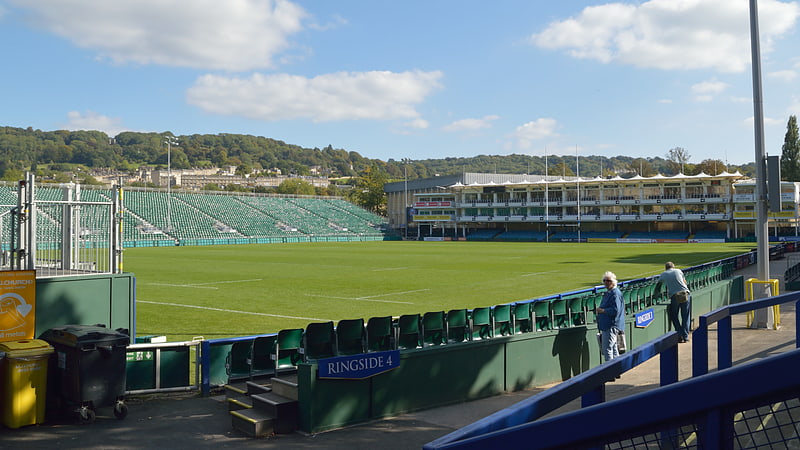
Sports ground in Bath, England. The Recreation Ground is a large open space in the centre of Bath, England, next to the River Avon, which is available to be used by permission from the Recreation Ground Trust for recreational purposes by the public at large but particularly the people of Bath and surrounding areas.
About a quarter of the Rec is leased to Bath Rugby during the rugby union season as a sports ground capable of holding 14,500 people. During the summer the rugby ground's temporary East Stand is removed to make way for cricket on a larger pitch. This cricket pitch is used for local contests and was used by Somerset County Cricket Club until 2011. Parts of the eastern area of the Rec are used by Bath Hockey Club, Bath Croquet Club, Bath Drama Club, Bath Quidditch Club and for some tennis courts. Pitches are available for amateur sports such as Football, Volleyball and Lacrosse. There is a cricket pavilion at the William Street entrance to the ground. The council-run Sports and Leisure Centre is located on the southern edge of the Rec, accessed via North Parade.
In former years the Rec was subject to periodic flooding from the River Avon, but a flood alleviation scheme in the 1960s improved the flow of the river. However, the Rec remains part of the floodplain at risk of occasional flooding. The ground can still get very boggy after heavy rains.[7]
Address: The Recreation Ground, BA 2 4 Bath
Guildhall
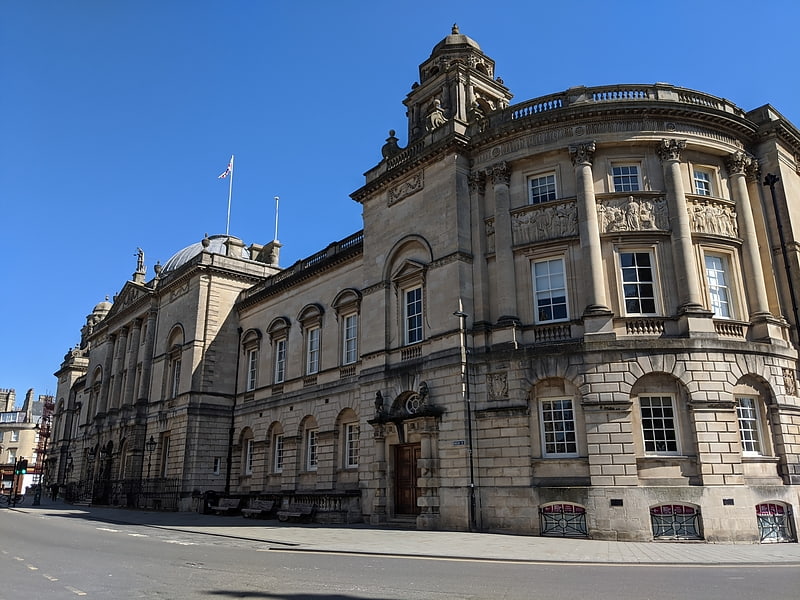
Event venue in Bath, England. Guildhall is an 18th-century municipal building in central Bath, Somerset, England. It is a Grade I listed building.[8]
Address: High St, BA2 4AW Bath
Royal Victoria Park
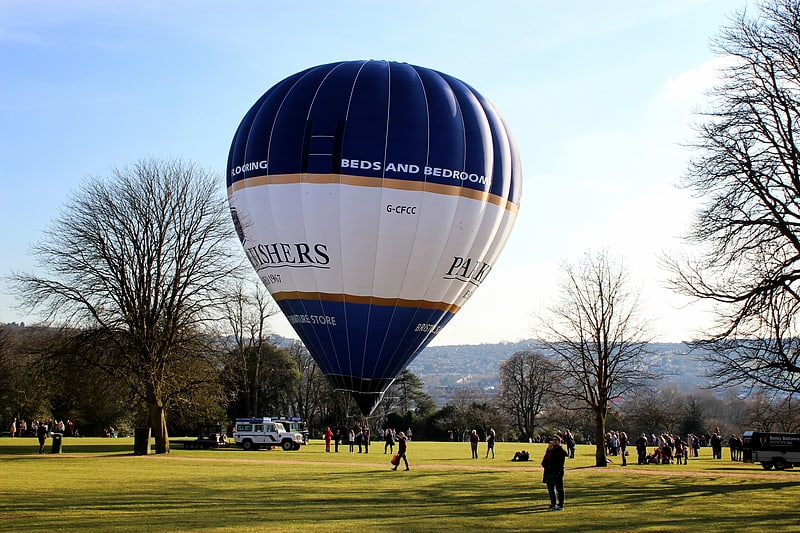
Park in Bath, England. Royal Victoria Park is located in Bath, England. It was opened in 1830 by the 11-year-old Princess Victoria seven years before her ascension to the throne and was the first park to carry her name, with an obelisk dedicated to her. It was privately run as part of the Victorian public park movement until 1921 when it was taken over by the Bath Corporation.
The park is overlooked by the Royal Crescent and consists of 57 acres (231,000 m²) with attractions that include a skateboard ramp, tennis, bowling and putting green and 12 and 18 hole golf course, open-air concerts, a large children's play area and a 9-acre (36,000 m²) botanical garden. Seasonal attractions include carnival fairs and hosted events.
It has received a Green Flag award, the national standard for parks and green spaces in England and Wales and is Grade I registered by Historic England on the National Register of Historic Parks and Gardens.[9]
Address: Royal Ave, BA1 2NQ Bath
Jane Austen Centre
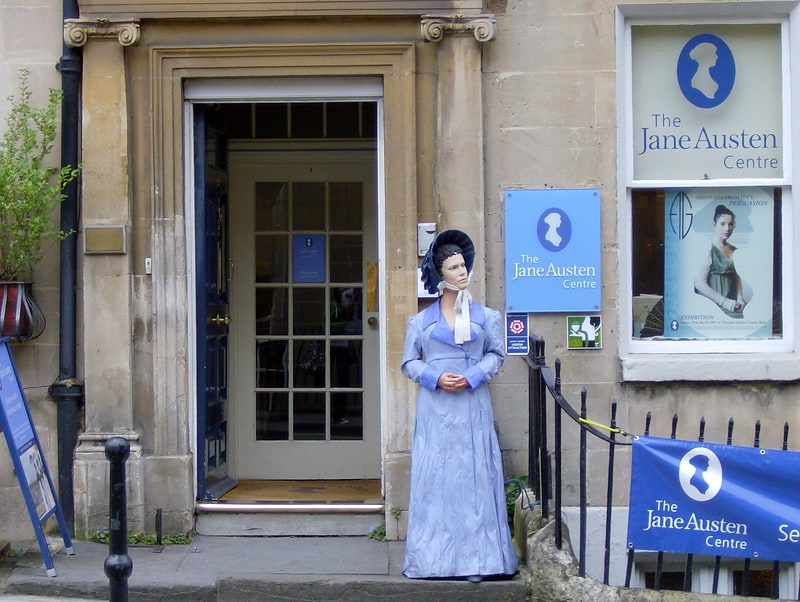
Museum of Jane Austen's life and tearooms. The Jane Austen Centre at 40 Gay Street in Bath, Somerset, England, is a permanent exhibition which tells the story of Jane Austen's Bath experience, and the effect that visiting and living in the city had on her and her writing.
The building is part of a block (31–40 Gay Street) which has been designated by English Heritage as a Grade II listed building.[10]
Address: 40 Gay St, BA1 2NT Bath
Bath Postal Museum
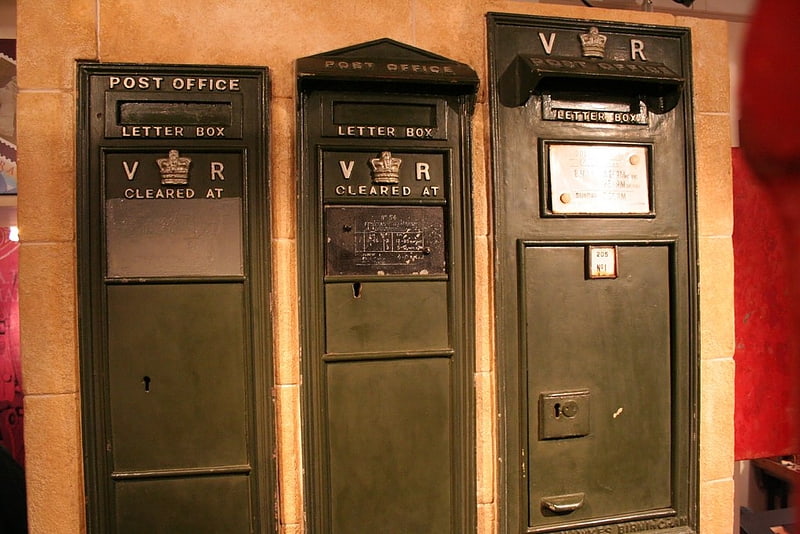
Museum in Bath, England. The Bath Postal Museum is in Bath, Somerset, England.
The museum was founded in 1979 by Audrey and Harold Swindells in the basement of their house in Great Pulteney Street. In 1985, it moved to a home in Broad Street. This was the site of Bath's main Post Office from 1822 to 1854 and the building in which the first recorded posting of a Penny Black took place on 2 May 1840. It has been designated by English Heritage as a grade II listed building.
The museum's collections include: biographies of key figures involved with the development of the Post Office and connected with Bath, such as Ralph Allen, John Palmer and Thomas Moore Musgrave; a history of the post from 2000BC to the current day and a history of the British postbox.
Artefacts on display included quills and ink wells, stamp boxes, post boxes, post horns, clay tablets, strip maps, model mail coaches, and letters and postcards. There was also a replica Victorian post office.
Due to vastly increased rent from 2003, the museum had to move out of the Broad Street building and on 7 November 2006 it reopened on a much smaller scale in the basement of the post office building at 27 Northgate Street.[11]
Komedia
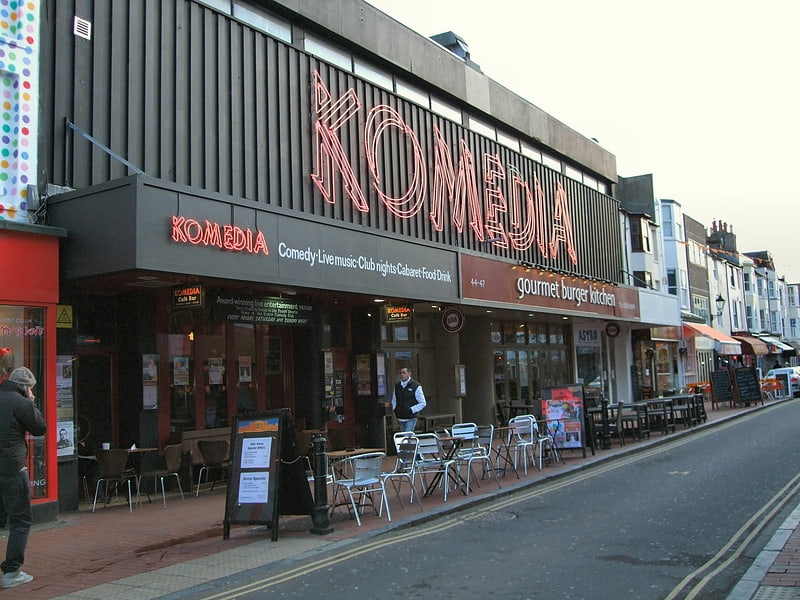
Komedia is an arts and entertainment company which operates venues in the United Kingdom at Brighton and Bath, and a management and production company Komedia Entertainment. Beyond hosting live comedy, the venues also host music, cabaret, theatre and shows for children, featuring local, national and international performers. The Brighton and Bath venues operate cinemas within their buildings in partnership with Picturehouse. Komedia also creates broadcast comedy and has most notably co-produced and hosted the live recordings of seven series of the Sony Award-winning Count Arthur Strong's Radio Show! for BBC Radio 4 and is a co-producer on BBC1's sitcom Count Arthur Strong.[12]
Address: 22-23 Westgate St, BA1 1EP Bath
Theatre Royal
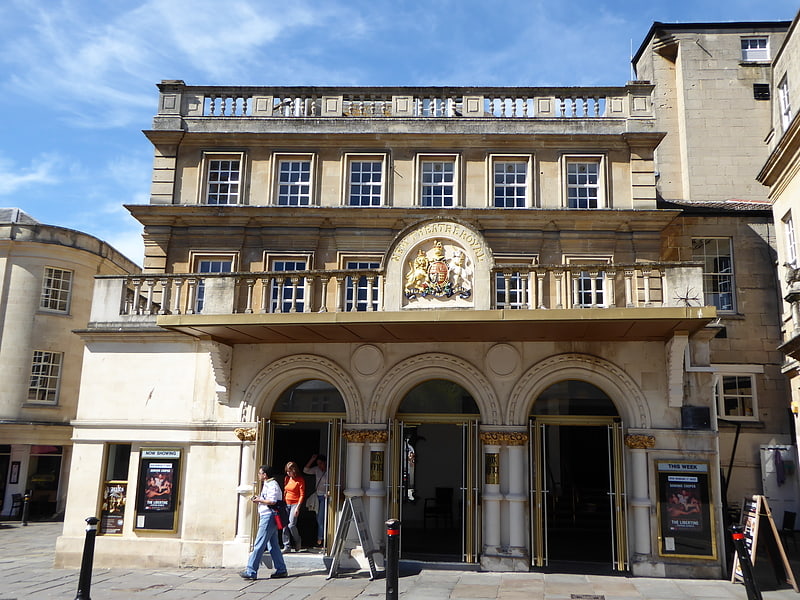
Theatre in Bath, England. The Theatre Royal in Bath, England, was built in 1805. A Grade II* listed building, it has been described by the Theatres Trust as "One of the most important surviving examples of Georgian theatre architecture". It has a capacity for an audience of around 900.
The Theatre Royal was built to replace the Old Orchard Street Theatre, funded by a Tontine and elaborately decorated. The architect was George Dance the Younger, with John Palmer carrying out much of the work. It opened with a performance of Shakespeare's Richard III and hosted performances by many leading actors of the time including Dorothea Jordan, William Macready and Edmund Kean. A major fire in 1862 destroyed the interior of the building and was quickly followed by a rebuilding programme by Charles J. Phipps, which included the construction of the current entrance. Further redecoration was undertaken in 1892; more extensive building work, including a new staircase and the installation of electric lighting, followed in 1902. Despite performances by casts including Sarah Bernhardt, the ballerina Anna Pavlova and Mrs. Patrick Campbell, the theatre was rarely very profitable. During World War II Donald Wolfit, Irene Vanbrugh, John Gielgud and Sybil Thorndike appeared, with shows including Noël Coward's Private Lives and Blithe Spirit, a performance by Ballet Rambert and light entertainment such as Charley's Aunt, but audiences declined.
In 1979 the theatre was bought by a trust and, following public donations, it underwent refurbishment, with the rebuilding of the stage and the installation of a new taller fly tower for scenery and lighting. In 1997 a new 120-seat theatre, known as the Ustinov Studio, was opened. Further restoration work to the main auditorium was needed in 2010. In 2005 a children's theatre known as The Egg was opened. The complex also includes bars and restaurants.[13]
Herschel Museum of Astronomy
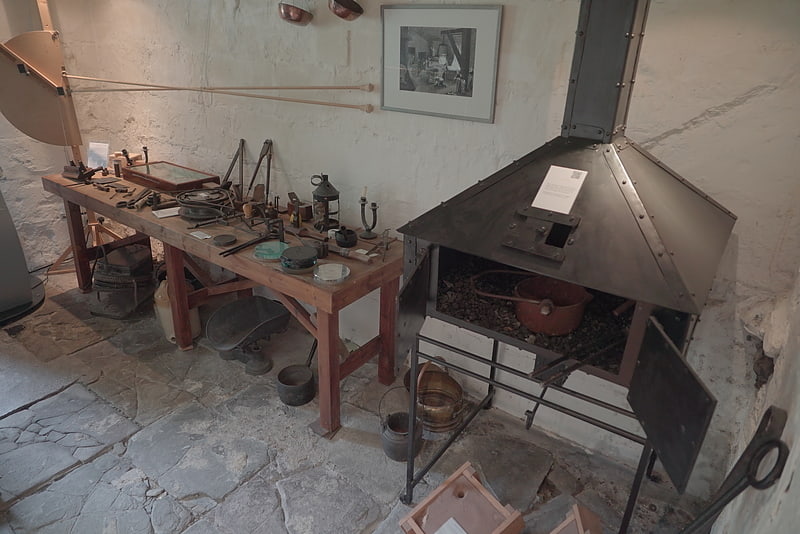
Displays on the astronomer's life and work. The Herschel Museum of Astronomy at 19 New King Street, Bath, England, is a museum that was inaugurated in 1981. It is located in a town house that was formerly the home of William Herschel and his sister Caroline.[14]
Address: 19 New King St, BA1 2BL Bath
Thermae Bath Spa

Building in Bath, England. Thermae Bath Spa is a combination of the historic spa and a contemporary building in the city of Bath, England, and reopened in 2006. Bath and North East Somerset council own the buildings, and, as decreed in a Royal Charter of 1590, are the guardians of the spring waters, which are the only naturally hot, mineral-rich waters in the UK. The Spa is operated by YTL Hotels.
The main spa building, the New Royal Bath, was designed by Grimshaw Architects and is constructed in Bath stone, enclosed by a glass envelope. It has two natural thermal baths, an open-air rooftop pool and an indoor pool, and a large Wellness Suite with two aromatic steam rooms, an Ice Chamber, Infrared Sauna and a Celestial Relaxation Room. It also has a cafe, three relaxation areas, and 27 spa treatment rooms, including the 18th century Hot Bath, in which water-based massage such as Watsu takes place. The separate Cross Bath is a grade I listed Georgian building containing one open-air thermal bath.[15]
Address: 6-8 Hot Bath St, BA1 1SJ Bath
Sydney Gardens Tunnels
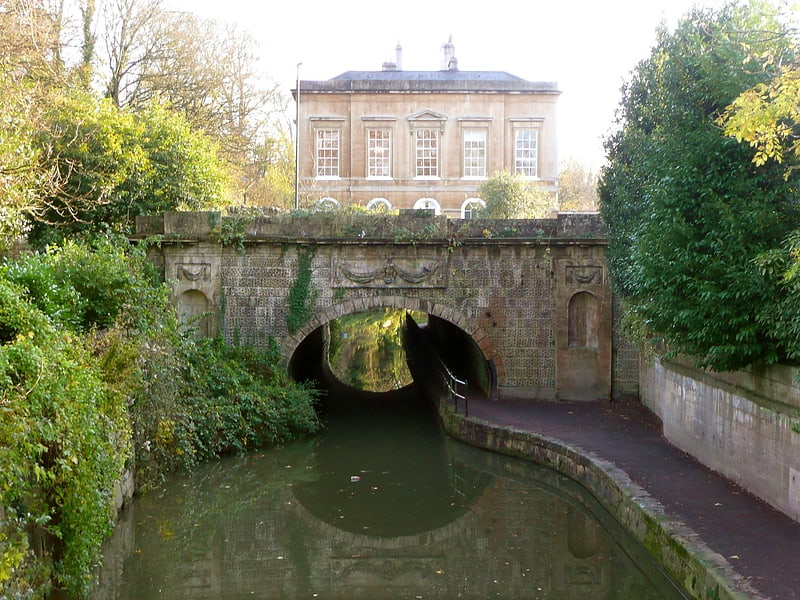
Tunnel in Bath, England. The Sydney Gardens Tunnels are two canal tunnels on the Kennet and Avon Canal in Bath, UK. The No. 1 Tunnel brings the canal into Sydney Gardens from the south and the No. 2 Tunnel exits the gardens to the north. Both tunnels are Grade II* listed, and are two of three on the waterway—the third being the Bruce Tunnel in Wiltshire.[16]
Grand Pump Room
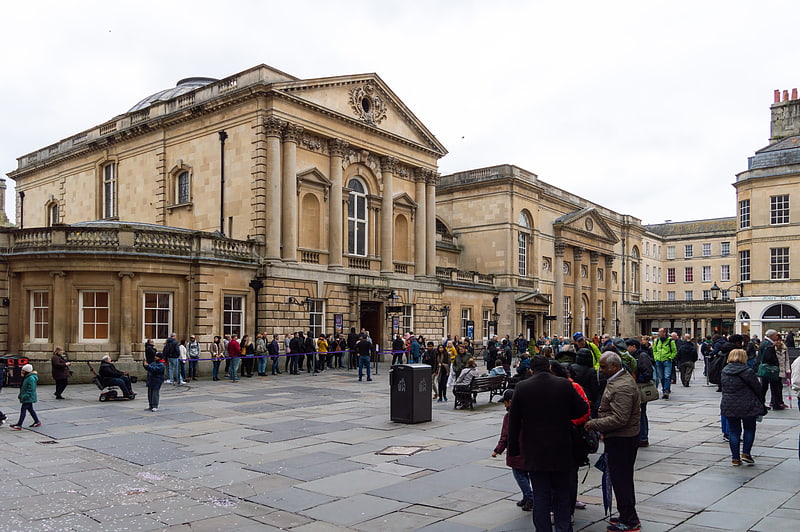
The Grand Pump Room is a historic building in the Abbey Church Yard, Bath, Somerset, England. It is adjacent to the Roman Baths and is named for water that is pumped into the room from the baths' hot springs. Visitors can drink the water or have other refreshments while there.
It has been designated as a Grade I listed building since 1950. Along with the Lower Assembly Rooms, it formed a complex where social activity was centred, and where visitors to the city gathered.[17]
Address: Stall St, BA1 1QL Bath
Sydney Gardens
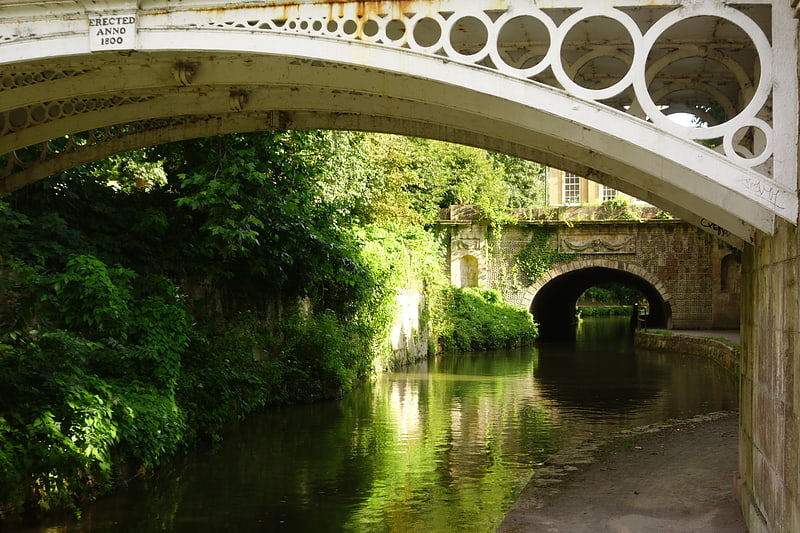
Park in Bath, England. Sydney Gardens is a public open space at the end of Great Pulteney Street in Bath, Somerset, England. The gardens are the only remaining eighteenth-century pleasure gardens in the country. They are Grade II listed on the Register of Historic Parks and Gardens of special historic interest in England.
The gardens were laid out in the 1790s, to plans by Thomas Baldwin which were completed by Charles Harcourt Masters, as a commercial pleasure garden with a variety of attractions. Features included a maze, grotto, sham castle and an artificial rural scene with moving figures powered by a clockwork mechanism. Events included promenades and public breakfasts which were attended by Jane Austen among others. It was also the venue for an annual flower show. The layout was affected by the construction of the Kennet & Avon Canal in 1810 and the Great Western Railway in 1840 which pass through the park. The gardens later fell into decline. In 1908, the site was bought by the local council and reopened as a park. Since 2015, work has been undertaken to improve the environment of the park and provide additional attractions for visitors.
The Sydney Hotel, which was built with the gardens, was the centre for entertainment. It is now the Holburne Museum. Other structures including the walls and bridges connected with the canal and railway are listed buildings along with small buildings now known as the pavilion and Minerva's temple and the public conveniences.[18]
Address: Sydney Pl, Bath
Holburne Museum
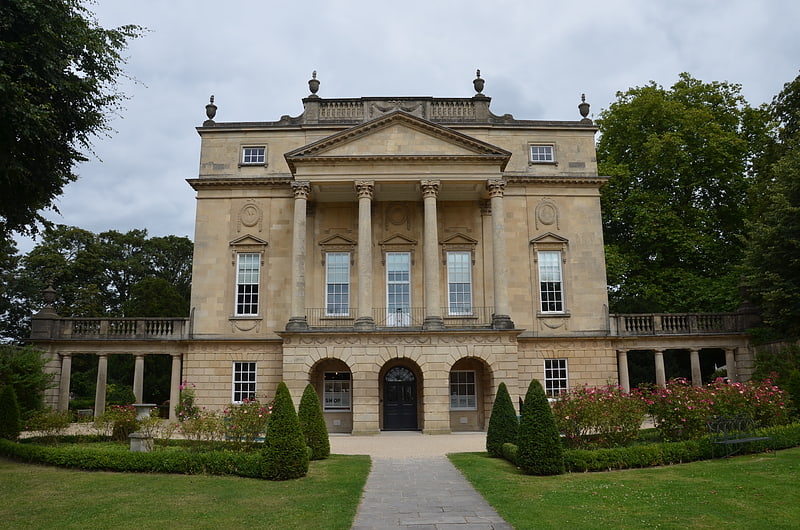
Art gallery in Bath, England. The Holburne Museum is located in Sydney Pleasure Gardens, Bath, Somerset, England. The city's first public art gallery, the Grade I listed building, is home to fine and decorative arts built around the collection of Sir William Holburne. Artists in the collection include Gainsborough, Guardi, Stubbs, Ramsay and Zoffany.
The museum also provides a programme of temporary exhibitions, music performances, creative workshops, family events, talks and lectures. There is a bookshop and a café that opens out onto Sydney Gardens. The museum reopened in May 2011 after restoration and an extension designed by Eric Parry Architects, supported by the Heritage Lottery Fund.[19]
Address: Great Pulteney St, BA2 4DB Bath
Dundas Aqueduct

Historical landmark in England. Dundas Aqueduct carries the Kennet and Avon Canal over the River Avon and the Wessex Main Line railway from Bath to Westbury. The aqueduct is near Monkton Combe, Somerset, and is about 2+1⁄2 miles southeast of the city of Bath.
It was designed by John Rennie and chief engineer John Thomas between 1797 and 1801, and completed in 1805. James McIlquham was appointed contractor. It is named after Charles Dundas, the first chairman of the Kennet and Avon Canal Company. The aqueduct is 150 yards (137.2 m) long with three arches built of Bath Stone, with Doric pilasters, and balustrades at each end. The central semi-circular arch spans 64 feet (19.5 m); the two oval side arches span 20 feet (6.1 m).
The canal crosses back across the Avon and the railway on another aqueduct at Avoncliff. This diversion onto the right bank of the Avon avoids the steep sides of the river valley at Limpley Stoke, and the need to cross the Midford Brook and River Frome.
It is a Grade I listed building, and was the first canal structure to be designated as a Scheduled Ancient Monument in 1951.
Over many years, leaks had developed and the aqueduct was closed in 1954. For a while in the 1960s and 1970s, the canal was dry and it was possible to walk along the bed on each side of the river, as well as through the aqueduct itself. The aqueduct was relined with polythene and concrete and restored, reopening in 1984. Care was taken not to disturb a colony of bats living under the aqueduct.
The aqueduct is also the junction between the Kennet and Avon Canal and the largely derelict Somerset Coal Canal. The short stretch of the Somerset Coal Canal still in water forms Brassknocker Basin, used for boat moorings, cycle hire and a cafe, and is next to Dundas Wharf where the small tollhouse, warehouse and crane still stand. The stretch of river below and above the aqueduct is used by Monkton Combe School Boat Club (Monkton Bluefriars) up to six days a week, since at least the 1960s. At the opposite (Wiltshire) end of the aqueduct a wharf was constructed serving the Conkwell stone quarries.
Between 2002 and 2004 further restoration was undertaken, which included replacing engineering bricks used by GWR with Bath Stone to match the original work.
In 2015, the railway below the aqueduct was lowered to allow the route to be used as a diversionary route for freight trains in the future. Network Rail published a time-lapse video of the work.[20]
Address: Brassknocker Hill, BA2 7JD Bath
The Forum

Building in Bath, England. The Forum was built as an art deco cinema in Bath, Somerset, England, in 1934, and was designated as a Grade II* listed building on 28 May 1986. The building closed as a cinema in 1969, and has subsequently been used as a dancing school, a bingo hall and a church. Its main auditorium has 1,600 seats, making it Bath's largest event venue.[21]
Address: St James Parade, BA1 1UG Bath
Prior Park
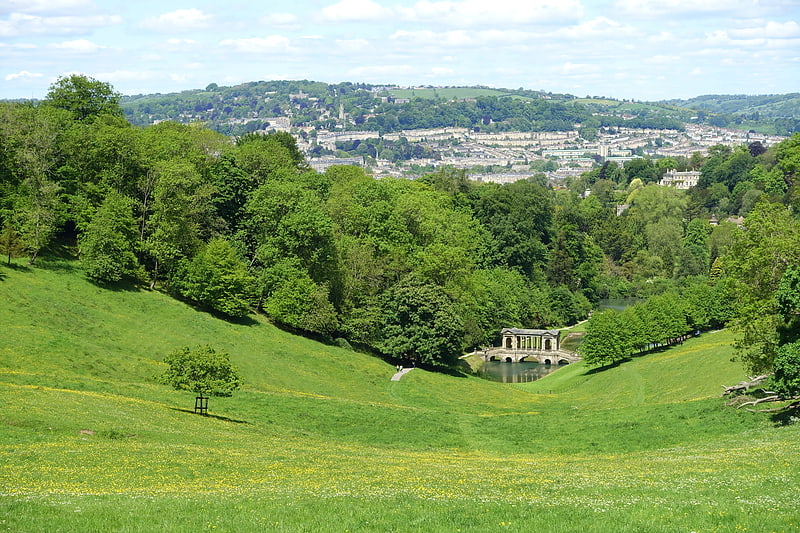
18th-century park with Palladian bridges. Prior Park Landscape Garden surrounding the Prior Park estate south of Bath, Somerset, England, was designed in the 18th century by the poet Alexander Pope and the landscape gardener Capability Brown, and is now owned by the National Trust. The garden was influential in defining the style known as the "English landscape garden" in continental Europe. The garden is Grade I listed in the Register of Historic Parks and Gardens of special historic interest in England.
Around 1100 the site was part of a deer park set out by the Bishop of Bath and Wells John of Tours. In 1720s it was bought by Ralph Allen and landscaped to complement his new house. Further development was undertaken after the house became a seminary and then a Roman Catholic grammar school (which later became Prior Park College). In the 1990s 11.3 hectares (28 acres) of the park and pleasure grounds were acquired by the National Trust and a large scale restoration undertaken. Features of Prior Park Landscape Garden include a Palladian architecture bridge, lake and ancillary buildings.[22]
Address: Landscape Gardens (NT) Ralph Allen Drive, BA2 5AH Bath
Prior Park
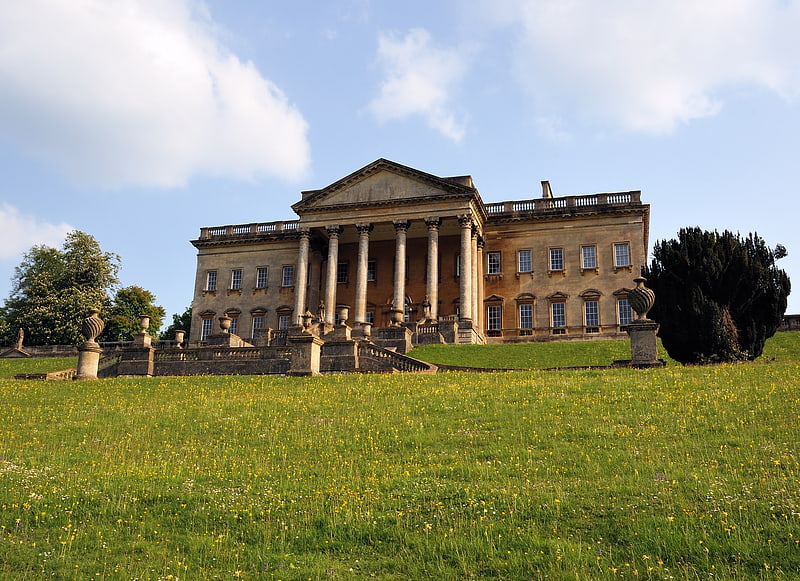
Building. Prior Park is a Neo-Palladian house that was designed by John Wood, the Elder, and built in the 1730s and 1740s for Ralph Allen on a hill overlooking Bath, Somerset, England. It has been designated as a Grade I listed building.
The house was built in part to demonstrate the properties of Bath stone as a building material. The design followed work by Andrea Palladio and was influenced by drawings originally made by Colen Campbell for Wanstead House in Essex as well as the twelve sided plan form of the Roman theatre (of which the house's natural setting reminded Wood). The main block had 15 bays and each of the wings 17 bays each. The surrounding parkland had been laid out in 1100 but following the purchase of the land by Allen 11.3 hectares (28 acres) were established as a landscape garden. Features in the garden include a bridge covered by Palladian arches, which is also Grade I listed.
Following Allen's death the estate passed down through his family. In 1828, Bishop Baines bought it for use as a Roman Catholic College. The house was then extended and a chapel and gymnasium built by Henry Goodridge. The house is now used by Prior Park College and the surrounding parkland owned by the National Trust.[23]
Address: Ralph Allen Drive, Bath
Fashion Museum
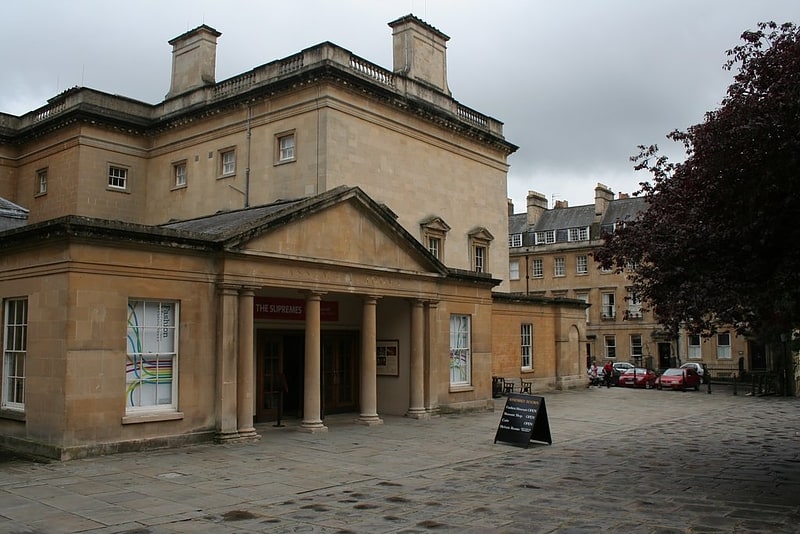
Museum in Bath, England. The Fashion Museum is housed in the Assembly Rooms in Bath, Somerset, England.
The collection was started by Doris Langley Moore, who gave her collection of costumes to the city of Bath in 1963. The museum focuses on fashionable dress for men, women and children from the late 16th century to the present day and has more than 100,000 objects. The earliest pieces are embroidered shirts and gloves from about 1600. The Museum receives about 100,000 visitors annually.[24]
Address: Assembly Rooms, Bennett St, BA1 2QH Bath
Museum of Bath at Work

Museum in Bath, England. The Museum of Bath at Work is a local history museum in Bath, Somerset, England.
The museum was established in 1978 as the Bath Industrial Heritage Trust. Its original collection consisted of a reconstruction of the nineteenth century engineering and mineral water business of Jonathan Burdett Bowler, founded in 1872. When the Bowler firm closed in 1969 its contents were bought by a local businessman with the express intention of founding a museum. Photographs taken of the original business were used to carefully reconstruct the shop, workshops, offices and bottling plant. Over 10,000 bottles and many thousands of documents were also saved.
Today, the museum seeks to present the commercial development of Bath over a 2000-year period. In addition to the Bowler collection, other reconstructions include a cabinet maker's workshop and a Bath stone quarry face complete with crane and tools. In 1999 a rare 1914 Horstmann car was acquired, and, in 2003, a comprehensive exhibition on Bath's development, 'Bath at Work: 2000 Years of Earning a Living' opened. A local history display in the Hudson Gallery opened in 2007 and features an ever-changing display of photographs. In 2007 the museum acquired a rare Griffin six-stroke gas engine, that had been in storage in Yeovil, Somerset, after having been moved from London in 2001. It was built in 1885 and for some years was in the Birmingham Museum of Science and Technology. It is one of only two known examples, the other being in the Anson Engine Museum.
The museum is housed in the Camden Works building, constructed in 1777 as a court for the indoor game of real tennis.[25]
Address: Camden Works, Julian Rd, BA1 2RH Bath
Bath Assembly Rooms
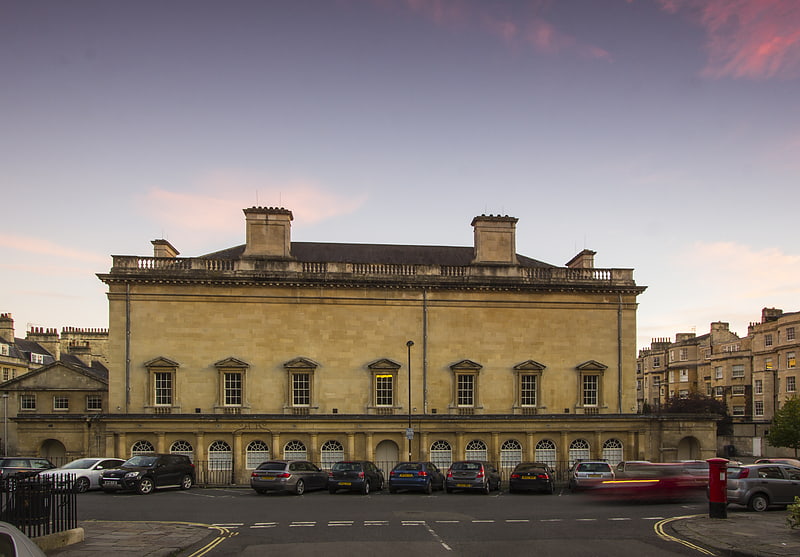
Building in Bath, England. The Bath Assembly Rooms, designed by John Wood the Younger in 1769, are a set of assembly rooms located in the heart of the World Heritage City of Bath in England which are now open to the public as a visitor attraction. They are designated as a Grade I listed building.
During the Georgian era Bath became fashionable, and the architects John Wood, the Elder, and his son laid out new areas of housing for residents and visitors. Assembly rooms had been built early in the 18th century, but a new venue for balls, concerts and gambling was envisaged in the area between Queen Square, The Circus and the Royal Crescent. Robert Adam submitted a proposal that was rejected as too expensive. John Wood, the Younger raised funding through a tontine, and construction started in 1769. The new or upper assembly rooms opened with a grand ball in 1771 and became the hub of fashionable society, being frequented by Jane Austen and Charles Dickens, along with the nobility of the time.
The building, made of Bath stone, is arranged in a U shape. There are four main function rooms in the complex: the 100-foot-long (30 m) ballroom — the largest Georgian interior in Bath; the tea room; the card room; and the octagon. The rooms have Whitefriars crystal chandeliers and are decorated with fine art.
In the 20th century they were used as a cinema and in 1931 were taken over by the Society for the Protection of Ancient Buildings and restored. They were bombed and burnt out during the Second World War, with restoration undertaken by Sir Albert Richardson before reopening in 1963. They are now owned by the National Trust and operated by Bath and North East Somerset Council for public functions. The basement of the building provides a home to the Fashion Museum.[26]
Address: Bennett St, Bath
St John's Church
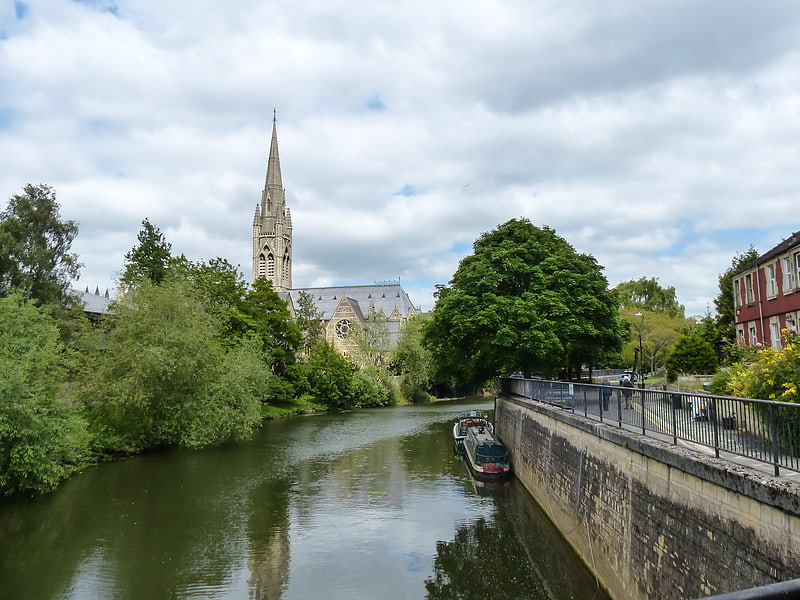
Catholic church in Bath, England. St. John the Evangelist Roman Catholic Church is located on the South Parade in the south-east section of Bath City Centre – the old Ham District where John Wood the Elder, the Georgian architect, had originally planned his gigantic "Forum".[27]
Address: South Parade, BA2 4AF Bath
Sham Castle
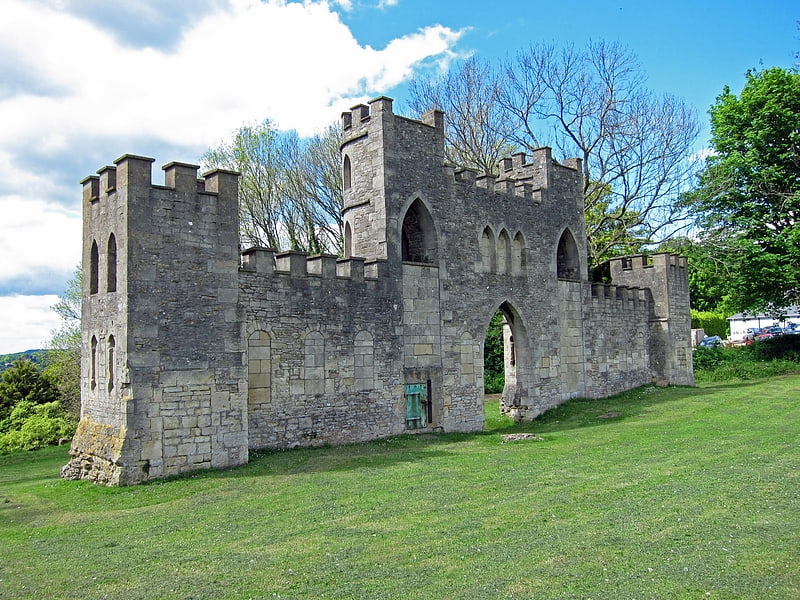
Castle in Bath, England. Sham Castle is a folly on Claverton Down overlooking the city of Bath, Somerset, England. It is a Grade II* listed building. It is a screen wall with a central pointed arch flanked by two 3-storey circular turrets, which extend sideways to a 2-storey square tower at each end of the wall.
It was probably designed around 1755 by Sanderson Miller and built in 1762 by Richard James, master mason for Ralph Allen, "to improve the prospect" from Allen's town house in Bath.
Sham Castle is now illuminated at night.[28]
Church of St Nicholas
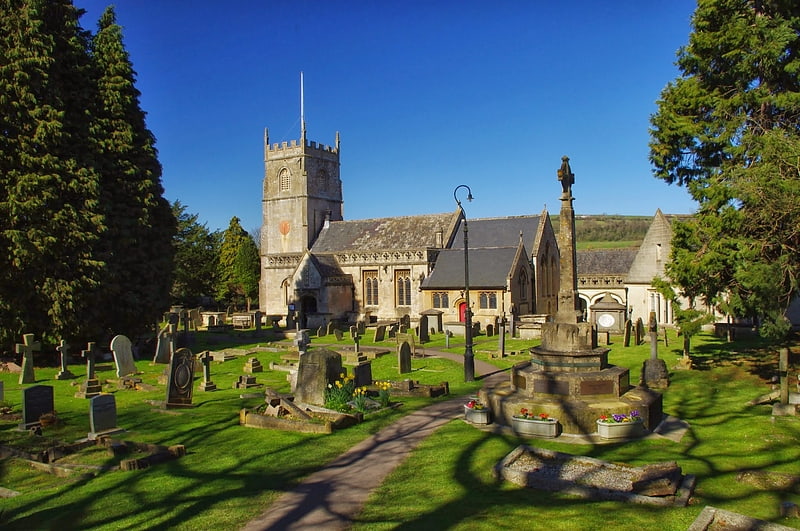
Parish church in Bathampton, England. The Church of St Nicholas is an Anglican parish church in Bathampton, Somerset, standing between the River Avon and the Kennet and Avon Canal. Built in the 13th century, with a 15th-century tower and 18th and 19th century restorations, it has been designated as a Grade II* listed building. The church is particularly noted for its Australia Chapel, which celebrates Admiral Arthur Phillip, the first Governor of New South Wales who was buried there in 1814, while the churchyard contains several other significant tombs.
The parish is part of the benefice of Bathampton with Claverton.[29]
Address: Church Cl, BA2 6TU Bath
Queen Square
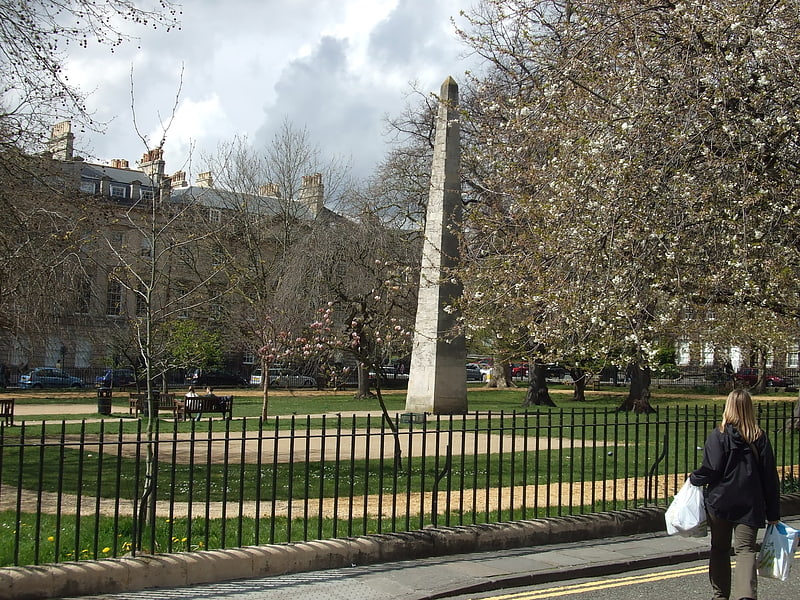
Queen Square is a square of Georgian houses in the city of Bath, England. Queen Square is the first element in "the most important architectural sequence in Bath", which includes the Circus and the Royal Crescent. All of the buildings which make up the square are Grade I listed.
The original development was undertaken by John Wood, the Elder in the early 18th century. He designed the building frontages following the rules of Palladian architecture and then sub-let to individual builders to put up the rest of the buildings. The obelisk in the centre of the square was erected by Beau Nash in 1738 in honour of Frederick, Prince of Wales.
During World War II several buildings on the south side of the square were damaged by bombing during the Bath Blitz. Following restoration many of the buildings are now offices with the west side housing the Bath Royal Literary and Scientific Institution and on the south side the Francis Hotel.[30]
Mission Theatre
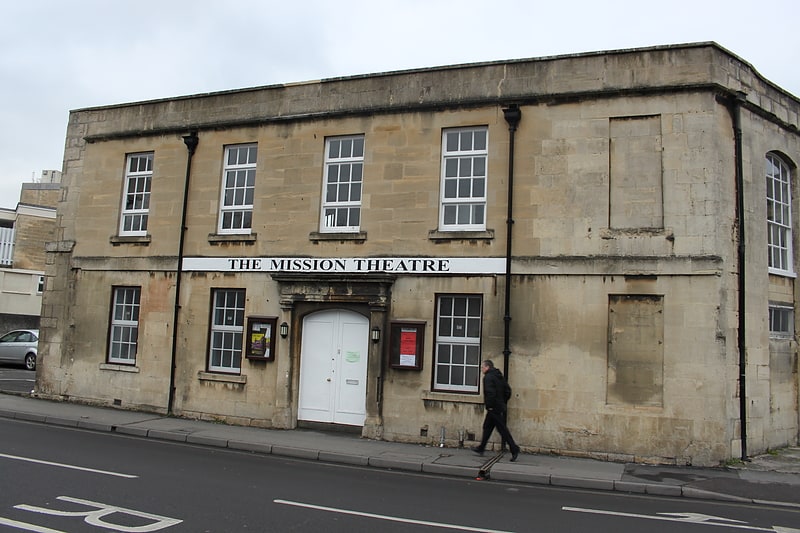
Theatre in Bath, England. The Mission Theatre is a theatre in Bath, England.
In 2004, the Next Stage Theatre Company took possession of a grade II listed building originally built as a Congregational hall in 1797. During World War II the building was used by Air Raid Wardens. It was used by The People's Mission until 1998, when building work began to convert it into a theatre.
It is now owned by the Bath and North East Somerset Council, which has granted a lease to occupy and use the building as a 100-seat theatre, arts centre and multi-purpose facility for community activities.
On the first floor there is a small 30-seat theatre (The Theatre Upstairs) and a Bistro open during the day and providing meals before performances in the theatre.[31]
Address: Bath, 32 Corn Street
Victoria Bridge

Suspension bridge in Bath, England. Victoria Bridge in Bath, England, was built in 1836 across the River Avon. The bridge has been recognised as a Grade II* listed building.
Victoria Bridge is an important example of a suspension bridge which initially carried horses and carts but later carried cyclists and pedestrians.[32]
Priston Mill
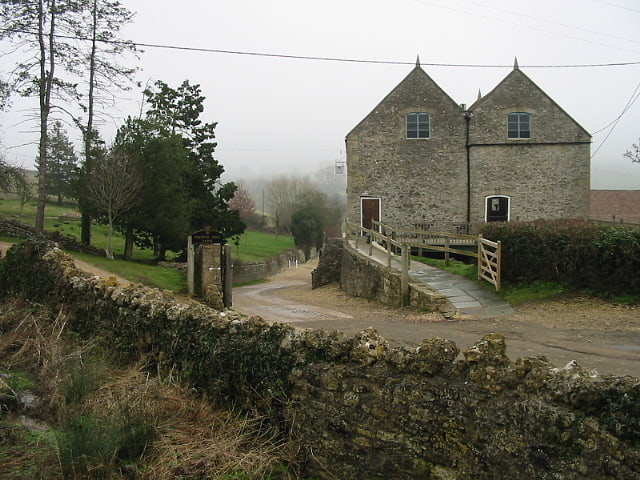
Priston Mill is a watermill in the district of Somerset, England. A Grade II listed building, it is near the city of Bath and currently serves as a venue for weddings and other gatherings.[33]
Museum of East Asian Art
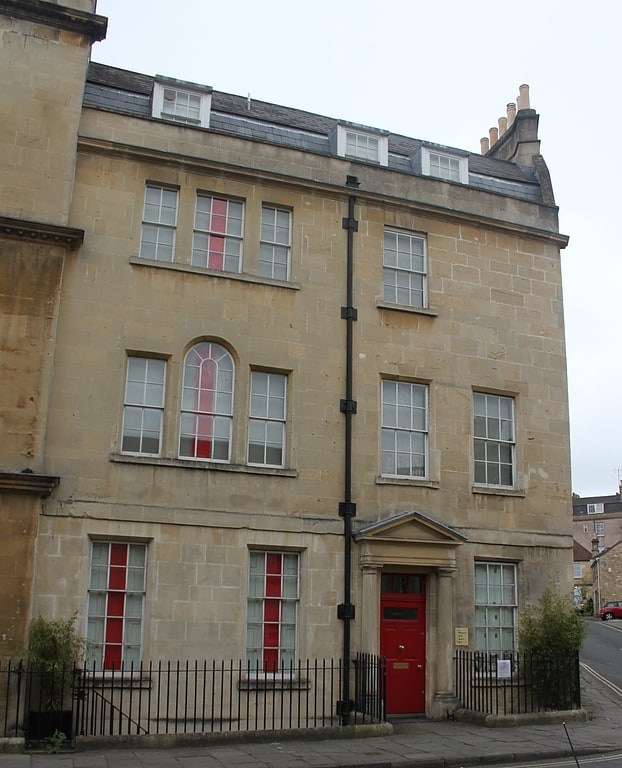
Museum in Bath, England. The Museum of East Asian Art or MEAA is in Bennett Street, Bath, Somerset, England.
Just a few metres off The Circus in central Bath, the Museum of East Asian Art is situated in a restored Georgian house. Its collection includesceramics, jades, bronzes and bamboo carvings and more, from China, Japan, Korea and Southeast Asia. It is the only museum in the United Kingdom dedicated solely to arts and cultures of East and Southeast Asia.
It houses a collection of almost 2,000 objects, ranging in date from c.5000 BCE to the present day. The Museum's collection started from the collection of Brian McElney, a retired solicitor who practised in Hong Kong for over 35 years, and has since been expanded.[34]
Address: 12 Bennett Street, BA1 2QJ Bath
Locksbrook Cemetery
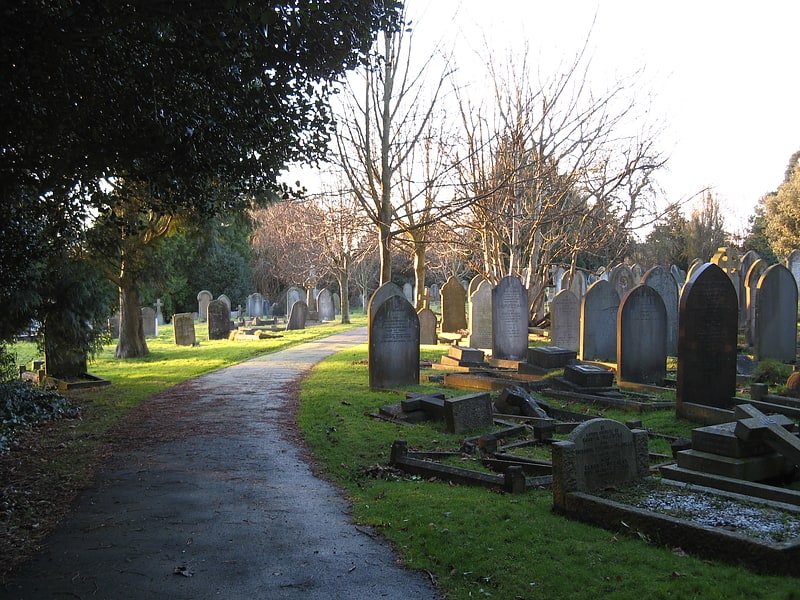
Cemetery in Bath, England. Locksbrook Cemetery is a municipal cemetery located in Lower Weston, Bath, England. It was opened in 1864 as Walcot Cemetery, and occupies 12 acres, originally serving the parishes of Walcot, Weston and St Saviour's. The cemetery was closed for general use in 1937 with over 30,000 interments there, though additional burials in existing graves continue. The majority of the cemetery was for about 29,500 burials from Walcot parish, with the north of the cemetery for Weston and St Saviour parishes.
Nowadays it is designated as a 'Nature Conservation Site' by Bath and North East Somerset council, its owners. The cemetery has several unusual species of tree including Phillyrea latifolia, Sequoiadendron giganteum, Ailanthus altissima, Thuja plicata and Japanese Cherry.[35]